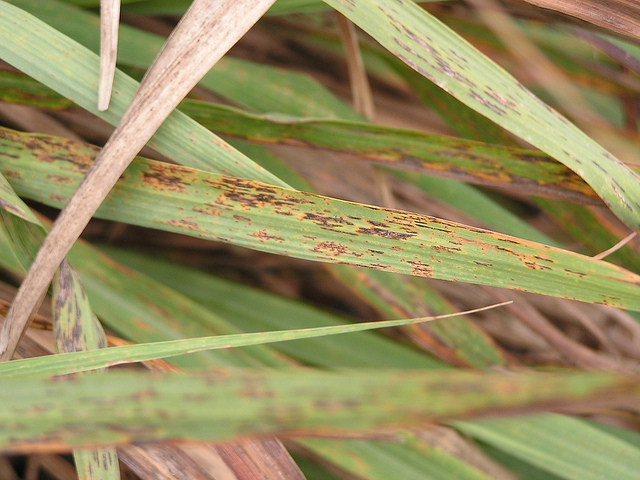Description
Lemongrass,
Cymbopogon citratus, is a perennial grass in the family Poaceae grown for its fragrant leaves and stalks which are used as a flavoring. The grass grows in dense clumps and has several stiff stems and slender blade-like leaves which droop towards the tips. The leaves are blue-green in color, turning red in the Fall and emit a strong lemon fragrance when damaged. Lemongrass produces large compound flowers on spikes when grown in the tropics, but rarely flowers when grown in more Northern latitudes. Lemon grass can reach a height of 1.8 m (6 ft) and will grow for several years, typically its economical lifespan is 4 years. Lemongrass may also be referred to as ginger grass or citronella grass and likely originates from Sri Lanka or Malaysia although a wild form of the plant is not known.

Lemon grass stems

Lemon grass leaves

Lemon grass
Uses
The stalks (leaf bases) of the plant are commonly used to flavor dishes in Southeast Asian cooking. The heart of young shoots may be cooked and consumed as a vegetable. The tougher leaves are used to flavor dishes but are typically removed before serving. Leaves may also be used to make lemon grass tea. The essential oil extracted from the leaves is commonly used in insect repellents, perfumes and soaps.
Propagation
Basic requirements
Lemongrass is a tropical plant and as such will grow best in warm, sunny and humid conditions of the tropics and subtropics. The plants can be grown at temperatures ranging from 10 to 33°C (50-91.4°F) but will grow optimally at temperatures between 25 and 30°C (77–86°F). The grass will grow in a wide range of soils but grows best in well-draining, fertile loam with a pH between 5.0 and 8.4. The grass can also be successfully grown in containers. Plants can be successfully grown in full sun or partial shade.
Propagation
As a clumping grass, lemongrass can be easily propagated by dividing stalks from the rhizome of a well established plant. The rhizome is best divided in the Spring in areas where the plant can be overwintered outdoors. In colder areas, the bulbous shoot base can be saved after harvest and stored for use the following Spring. The bulb can be divided prior to planting by slicing through the rhizome with a sharp spade or trowel. Ensure that each new plant has its own rootstock.
Planting
Commercially grown lemongrass is planted at a higher density than in the home garden with a within row spacing of 20 cm (8 in) and 40 cm (16 in). In the home garden, plants should be spaced between 90 and 150 cm (36-60 in) apart. Prepare the soil for planting by working in 2 to 4 inches of compost.
General care and maintenance
Lemongrass requires regular rainfall and if being grown in drier climates the plants should be watered and misted regularly. Plants have a heavy requirement for nitrogen during the growing season and should be fertilized with a balanced soluble fertilizer once a month. Container grown plants should be fed more frequently. Lemongrass can grow very large and will quickly out compete weeds. However, younger plants should be kept free by carefully cultivating or hand pulling any weeds from around the plants.
Harvesting
Lemongrass can be harvested at any time once the stalks have reached 1.3 cm (0.5 in) in diameter. Harvest stalks by cutting them at ground level with a sharp knife, or by bending the stalk and twisting.
References
CABI Crop Protection Compendium. (2013). Cymbopogon citratus (citronella grass) datasheet. Available at: http://www.cabi.org/cpc/datasheet/17377. [Accessed 10 February 15].
Paid subscription required.
Gilman, E.F. (1999). Cymbopogon citratus. University of Florida IFAS Extension. Available at: http://hort.ufl.edu/database/documents/pdf/shrub_fact_sheets/cymcita.pdf. [Accessed 10 February 15].
Free to access
Linse, T. & Drost, D. Lemongrass. University of Florida IFAS Extension. Available at: http://nassau.ifas.ufl.edu/horticulture/demogarden/printables/Lemongrass.pdf. [Accessed 10 February 15].
Free to access








